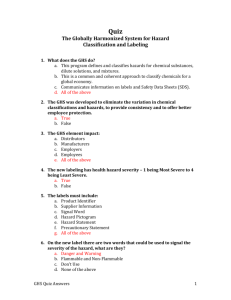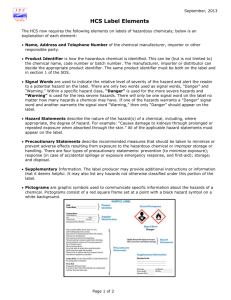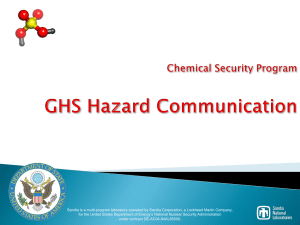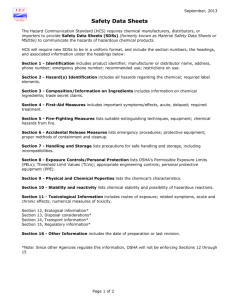GHS Hazcom Manual
advertisement
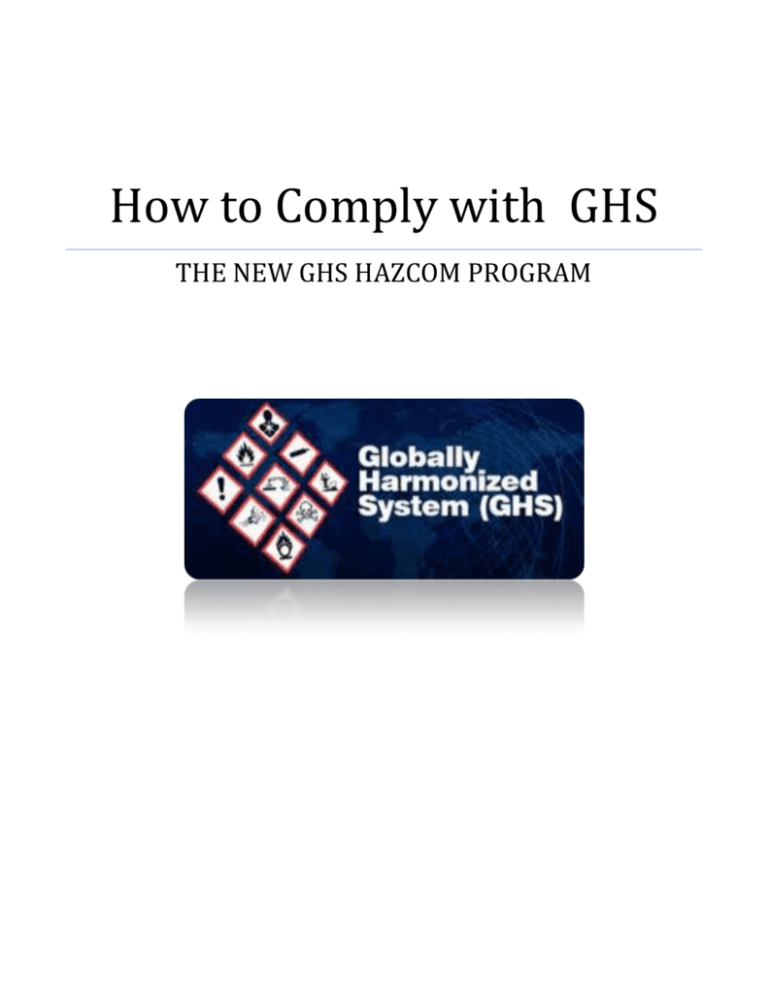
How to Comply with GHS THE NEW GHS HAZCOM PROGRAM TABLE OF CONTENTS Page No. Introduction................................................................................................................................. 4 Benefits of GHS .......................................................................................................................... 5 Benefits of the Proposed Standard ............................................................................................. 4 Changes to HAZCOM ................................................................................................................. 8 Comment Period......................................................................................................................... 5 Hazard Classification .................................................................................................................. 9 Hazard Communication Standard (HCS) .................................................................................... 6 HCS Pictograms & Hazards...................................................................................................... 10 Impact of the Proposed HCS ...................................................................................................... 5 Labels ......................................................................................................................................... 9 New Safety Data Sheets ........................................................................................................... 11 Public Hearings .......................................................................................................................... 6 Summary .................................................................................................................................. 12 ****** 2 DISCLAIMER Information provided in this written material should not be considered as all-encompassing, or suitable for all situations, conditions or environments. Each company is responsible for implementing their own safety/injury/illness prevention program and should consult with their legal, medical or other advisors as to the suitability of using this information. Application of this information does not guarantee you will be successful in your safety efforts, or that the information will meet acceptable standards or requirements. At the time this information was provided, it was believed to be from reliable sources and current with applicable safety standards, however, the producers of the program assume no liability arising from the use of, or reliance on the information provided. Always seek the advice of your legal, medical or other advisors as necessary before using this information in your Company's safety efforts. ***** 3 HOW TO COMPLY WITH THE NEW GHS HAZCOM PROGRAM INTRODUCTION There is a lot of information about the new Hazard Communications program that’s changing the way organizations comply with the new rules. This program is an explanation of how to comply, without changing your entire HAZCOM program. The purpose of the Hazard Communication Standard, or HCS, is to protect workers in all industries from the effects of hazardous chemicals. The HCS informs workers of the chemicals with which they are working, the hazards associated with those chemicals and how to protect themselves. The Globally Harmonized System (GHS) is an international approach to hazard communication, providing agreed criteria for classification of chemical hazards, and a standardized approach to label elements and safety data sheets. It is based on major existing systems around the world, including OSHA's Hazard Communication Standard and the chemical classification and labeling systems of other US agencies. Benefits of GHS The primary benefit of the GHS is to increase the quality and consistency of information provided to workers, employers and chemical users by adopting a standardized approach to hazard classification, labels and safety data. The GHS provides a single set of harmonized criteria for classifying chemicals according to their health and physical hazards and specifies hazard communication elements for labeling and safety data sheets. Under the GHS, labels would include signal words, pictograms, and hazard and precautionary statements and safety data sheets would have standardized format. This system was agreed on at an international level by governments, industry, and labor, and adopted by the UN in 2002 with a goal of 2008 for implementation. The number of workers affected by HCS – over 40 million workers. Affected industries – over 5 million workplaces. Impact of the proposed HCS: The costs associated with compliance with the proposed revisions to the HCS would generally be incurred by the affected industries as one-time transition costs over the phase-in period of three years. The cost includes reclassification of all chemicals, additional training of workers on the new 4 label elements and SDS format, and familiarization of the modified HCS standard. Aside from the transition costs, the ongoing annual compliance costs associated with the proposed revisions to the HCS generally are expected to be the same or lower than under the existing standard. Annualized compliance costs of the proposed standard: Approximately $97 million per year OSHA estimates that the cost of classifying chemical hazards in accordance with the GHS criteria and revising safety data sheets and labels to meet new format and content requirements would be $11 million a year on an annualized basis for an estimated 90,000 establishments. OSHA estimates that training for workers to become familiar with new warning symbols and the revised safety data sheet format under GHS would cost $44 million a year on an annualized basis for all affected workplaces. Although not a requirement in the proposed rule, OSHA estimated annualized costs of $42 million a year for management to become familiar with the new GHS system and to engage in other management-related activities as may be necessary for industry's adoption of GHS. Benefits of the proposed standard: OSHA estimates that the revised standard will prevent 43 fatalities and 585 injuries and illnesses annually. The annualized monetized benefits associated with these reductions in safety and health risks are an estimated $266 million a year. OSHA estimates additional annualized benefits of $585 million a year from cost reductions and productivity improvements attributable to the proposed revisions. In total, OSHA estimates that the proposed revisions will provide net annualized savings of $754 million a year. Comment Period: OSHA is allowing 90 days for the comment period. Interested parties can submit their comments by mail, facsimile or electronically. OSHA welcomes questions on all relevant issues of this proposed rulemaking including hazard classification, economic impacts and specifically impacts on small businesses, other affected standards, outreach, and finally alternative approaches. Public Hearings: OSHA will be conducting informal public hearings and will publish a separate federal register notice on the date and location(s) for the hearings. 5 Hazard Communication Standard (HCS) On March 26, 2012, OSHA published the revised Hazard Communication Standard (HCS) to adopt the Globally Harmonized System of Classification and Labeling of Chemicals (GHS). The change is expected to prevent injuries and illnesses, save lives, and reduce trade barriers for chemical manufacturers. According to OSHA, for nearly 30 years the original HCS gave workers the “right to know” about chemical hazards in their workplace, but the revised HCS now gives them the “right to understand” those hazards. The latest HCS requires chemical manufacturers and importers to follow a mostly GHS-based method to “classify” the hazards of the chemicals they produce or import, and then prepare labels and safety data sheets (SDSs) with standardized information to convey the hazards and associated protective measures to employers and employees. This approach should result in more consistent, accurate, and easier-to-read labels and data sheets, says OSHA. Also training employees in the new systems should be more straightforward for employers. Information about chemicals is provided in material safety data sheets. These papers must be sent with any chemical when it is transported. Businesses that routinely use a specific chemical are required to keep a chemical inventory and an MSDS for every chemical on site. If the business stops using that chemical, it must dispose of the MSDS. An MSDS communicates the hazards a chemical presents, such as whether it is an irritant or if it has noxious fumes. An MSDS must also communicate information such as flammability and the upper and lower explosive limits. Significant changes to the HCS, found at 29 CFR 1910.1200, cover: Revised criteria for classifying physical and health hazards of chemicals, as well as mixtures; Revised labeling provisions, including the use of harmonized signal words, pictograms, hazard statements, and precautionary statements; A standardized 16-section SDS format; Employee training in the new label elements and SDS format; and New, revised, and removed definitions. As before, all employers with hazardous chemicals in their workplaces will still be required to maintain a written hazard communication program, ensure proper hazardous chemical container labeling, and provide employees with ready access to SDSs. The new rule offers employers the flexibility to use an alternative in-house chemical labeling system in their workplace, as long as the information on these labels meets the workplace labeling requirements specified in the revised HCS. 6 While the rule was effective May 25, 2012, a new paragraph (j) to §1910.1200 provides extended compliance dates as follows: December 1, 2013 — Employers must have trained employees on the new labeling elements and SDS format. June 1, 2015 — Chemical manufacturers, importers, distributors, and employers must comply with all modified provisions of the HCS, with exception of the compliance dates below. December 1, 2015 — Chemical distributors must not ship containers labeled by the chemical manufacturer or importer unless it has a label that complies with the modified labeling provisions. June 1, 2016 — Employers must update alternative workplace labeling and their information and training programs as necessary and provide additional employee training for newly identified physical or health hazards. During the phase-in period, employers would be required to be in compliance with either the old HCS or the revised HSC, or both. Also, during the phase-in, labels and SDSs under both standards may be present in the workplace, and employers are not required to maintain two sets of labels and SDSs for compliance purposes, according to an agency statement. The result of this negotiation process is the United Nations' document entitled "Globally Harmonized System of Classification and Labeling of Chemicals," commonly referred to as “The Purple Book.” OSHA has modified the Hazard Communication Standard (HCS) to adopt the GHS to improve safety and health of workers through more effective communications on chemical hazards. The GHS provides a standardized approach, including detailed criteria for determining what hazardous effects a chemical poses, as well as standardized label elements assigned by hazard class and category. This will enhance both employer and worker comprehension of the hazards, which will help to ensure appropriate handling and safe use of workplace chemicals. In addition, the safety data sheet requirements establish an order of information that is standardized. The harmonized format of the safety data sheets will enable employers, workers, health professionals, and emergency responders to access the information more efficiently and effectively, thus increasing their utility. Adoption of the GHS in the U.S. and around the world will also help to improve information received from other countries—since the U.S. is both a major importer and exporter of chemicals, American workers often see labels and safety data sheets from other countries. The diverse and sometimes 7 conflicting national and international requirements can create confusion among those who seek to use hazard information effectively. During the phase-in period, employers would be required to be in compliance with either the existing HCS or the revised HCS, or both. OSHA recognizes that hazard communication programs will go through a period of time where labels and SDSs under both standards will be present in the workplace. This will be considered acceptable, and employers are not required to maintain two sets of labels and SDSs for compliance purposes. CHANGES TO HAZCOM OSHA is requiring that employees are trained on the new label elements, such as pictograms and signal words and the new SDS format by December 2013. While many countries are in various stages of implementing the GHS, OSHA believes that it is possible that American workplaces may begin to receive labels and SDSs that are consistent with the GHS shortly after publication. Thus, making it important to ensure that when employees begin to see the new labels and SDSs in their workplaces, they will be familiar with them, understand how to use them, and access the information effectively. The three major areas of change are in hazard classification, labels, and safety data sheets. • Hazard classification: The definitions of hazard have been changed to provide specific criteria for classification of health and physical hazards, as well as classification of mixtures. These specific criteria will help to ensure that evaluations of hazardous effects are consistent across manufacturers, and that labels and safety data sheets are more accurate as a result. • Labels: Chemical manufacturers and importers will be required to provide a label that includes a harmonized signal word, pictogram, and hazard statement for each hazard class and category. Precautionary statements must also be provided. • Safety Data Sheets: Will now have a specified 16-section format. The revised Hazard Communication Standard (HCS) is a modification to the existing standard. The parts of the standard that did not relate to the GHS remained largely unchanged. There have been some modifications to terminology in order to align the revised HCS with language used in the GHS. For example, the term "hazard determination" has been changed to "hazard classification" and "material safety data sheet" was changed to "safety data sheet." HAZARD CLASSIFICATION Under both the current Hazard Communication Standard (HCS) and the revised HCS, an evaluation of chemical hazards must be performed considering the available scientific evidence concerning such hazards. The revised HCS has specific criteria for each health and physical hazard, along with 8 detailed instructions for hazard evaluation and determinations as to whether mixtures or substances are covered. It also establishes both hazard classes and hazard categories—for most of the effects; the classes are divided into categories that reflect the relative severity of the effect. The current HCS does not include categories for most of the health hazards covered, so this new approach provides additional information that can be related to the appropriate response to address the hazard. LABELS Under the current Hazard Communication Standard (HCS), the label preparer must provide the identity of the chemical, and the appropriate hazard warnings. This may be done in a variety of ways, and the method to convey the information is left to the preparer. Under the revised HCS, once the hazard classification is completed, the standard specifies what information is to be provided for each hazard class and category. Labels will require the following elements: • Pictogram: a symbol plus other graphic elements, such as a border, background pattern, or color that is intended to convey specific information about the hazards of a chemical. Each pictogram consists of a different symbol on a white background within a red square frame set on a point (i.e. a red diamond). There are nine pictograms under the GHS. However, only eight pictograms are required under the HCS. • Signal words: a single word used to indicate the relative level of severity of hazard and alert the reader to a potential hazard on the label. The signal words used are "danger" and "warning." "Danger" is used for the more severe hazards, while "warning" is used for less severe hazards. • Hazard Statement: a statement assigned to a hazard class and category that describes the nature of the hazard(s) of a chemical, including, where appropriate, the degree of hazard. • Precautionary Statement: a phrase that describes recommended measures to be taken to minimize or prevent adverse effects resulting from exposure to a hazardous chemical or improper storage or handling of a hazardous chemical. There are nine pictograms under the GHS to convey the health, physical and environmental hazards. The final Hazard Communication Standard (HCS) requires eight of these pictograms, the exception being the environmental pictogram, as environmental hazards are not within OSHA's jurisdiction. A quick look at the hazard pictograms and their corresponding hazards There are nine pictograms under the GHS to convey the health, physical and environmental hazards. 9 The following is the hazard pictograms and their corresponding hazards. HCS Pictograms and Hazards Health Hazard Carcinogen -• Mutagenicity - Reproductive Toxicity - •Respiratory Sensitizer - Target Organ Toxicity Aspiration Toxicity. Flame Flammables - Pyrophorics - Self-Heating - Emits Flammable Gas - Self-Reactives - Organic Peroxides. Exclamation Mark Irritant (skin and eye) - Skin Sensitizer - Acute Toxicity (harmful) - Narcotic Effects - Respiratory Tract Irritant - Hazardous to Ozone Layer (non-mandatory). Gas Cylinder Gases under Pressure Corrosion Skin Corrosion/burns – Eye Damage – Corrosive to Metals Exploding Bomb Explosives – Self-Reactives – Organic Peroxides Flame over Circle Oxidizers Environment (Non-Mandatory) Aquatic Toxicity Skull and Crossbones Aquatic Toxicity (fatal or toxic) 10 MORE ON PICTOGRAMS Under the revised Hazard Communication Standard (HCS), pictograms must have red borders. OSHA believes that the use of the red frame will increase recognition and comprehensibility. Therefore, the red frame is required regardless of whether the shipment is domestic or international. The revised Hazard Communication Standard (HCS) requires that all red borders printed on the label have a symbol printed inside it. Employers may choose to label workplace containers either with the same label that would be on shipped containers for the chemical under the revised rule, or with label alternatives that meet the requirements for the standard. Alternative labeling systems such as the National Fire Protection Association (NFPA) 704 Hazard Rating and the Hazardous Material Information System (HMIS) are permitted for workplace containers. However, the information supplied on these labels must be consistent with the revised HCS, such as no conflicting hazard warnings or pictograms. NEW SAFETY DATA SHEETS The information required on the safety data sheet (SDS) will remain essentially the same as that in the current standard. The current Hazard Communication Standard (HCS) indicates what information has to be included on an SDS but does not specify a format for presentation or order of information. The revised HCS requires that the information on the SDS is presented using consistent headings in a specified sequence. The SDS format is the same as the ANSI standard format which is widely used in the U.S. and is already familiar to many employees. The format of the 16-section SDS should include the following sections: Section 1. Identification Section 2. Hazard(s) identification Section 3. Composition/information on ingredients Section 4. First-Aid measures Section 5. Fire-fighting measures Section 6. Accidental release measures Section 7. Handling and storage Section 8. Exposure controls/personal protection Section 9. Physical and chemical properties 11 Section 10. Stability and reactivity Section 11. Toxicological information Section 12. Ecological information Section 13. Disposal considerations Section 14. Transport information Section 15. Regulatory information Section 16. Other information, including date of preparation or last revision Sections 12-15 may be included in the SDS, but are not required by OSHA. OSHA anticipates that, in addition to safety and health benefits, the revised HCS will result in four types of productivity benefits: (1) for chemical manufacturers, because they will need to produce fewer SDSs in future years; (2) for employers, in providing training to new employees as required by the existing OSHA HCS through the improved consistency of the labels and SDSs. (3) for firms engaging in, or considering engaging in, international trade. SUMMARY Basically, if you have a current Hazard Communication Program, including a written program, inventory control and training, the major changes that will affect most companies will be the Safety Data Sheet, Labels and Pictograms. The changes from MSDS to SDS will make it much easier to standardize the Safety Data Sheets as the required information will be in the same place on each SDS. Label changes are easy to do and almost every label vendor now has these new labels available. Pictograms will take just a while longer to learn and implement, but this will simplify the information for almost everyone using chemicals and hazardous materials. Training is always an important part of any new program. Organizations with a current HAZCOM program can make these adjustments quickly and include these new basics in training. Overall, GHS is nothing to fear, it’s a simplified system and in the long run, will result in greater efficiency, productivity and of course, great safety and health for anyone working with chemicals and hazardous materials. ***** 12
